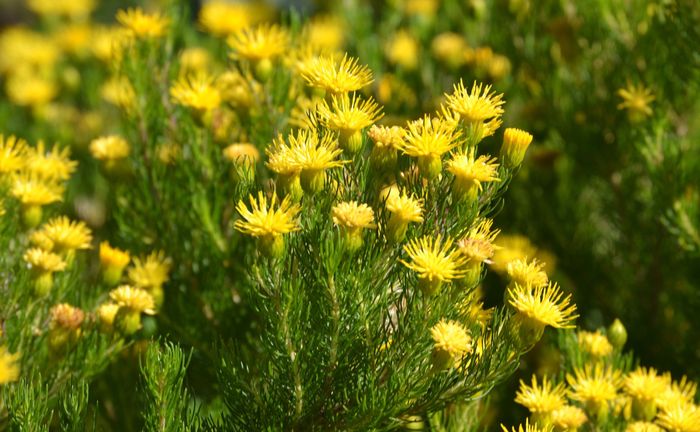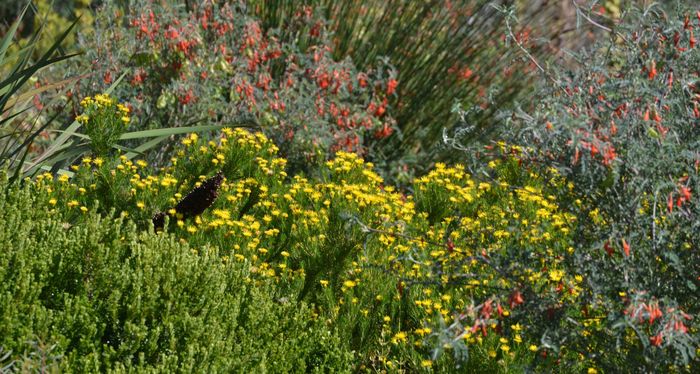Pteronia aspera
Pteronia aspera Thunb.
Family: Asteraceae
Common names: sand gumbush (Eng.); sandgombos (Afr.)
Introduction
A floriferous, medicinally important shrub, with huge cultural value and commercial potential.

Description
Description
A much-branched, evergreen, aromatic shrub 1–2 m tall, that resprouts after fires. Branches densely covered in small hairs or bristles. Leaves alternate, narrow, linear to filiform, 1 mm wide and 8–40 mm long, hairless or covered with bristles all over the surface, with white hairs on the margins (ciliate). Discoid, yellow flowerheads, solitary and grouped at the ends of the branches, 15 × 15 mm. The short yellow floral tube is slightly hairy. Involucral bracts are glabrous, with serrated margins. Flowering is in spring and early summer (September to December). Seed dispersal is in summer, from November to January. Pappus uniseriate, bristles, connate at the base, 6–9 mm long, slightly shorter than florets at fruiting stage, straw-coloured. Cypselas ovate, 3–4 × 1.5–2.0 mm, dorsoventrally flattened, marginal ribs slightly prominent, usually contracted into a neck at apex, glabrous, brown, shiny.

Conservation Status
Status
The conservation status of this species is assessed Least Concern (LC).
Distribution and habitat
Distribution description
This widespread species is found from the Kamiesberg-area in Namaqualand in the Northern Cape to the Cape Peninsula and eastwards to the Langeberg and Rooiberg Mountains, in the Western Cape, in South Africa. It occurs from sea level to 1 230 m altitude, and generally occupies sandy coastal areas to upper slopes, however, in some habitats in the Klein-Karoo, plants can often be found growing en masse along the moist, loamy soils along rivers of the area.

Derivation of name and historical aspects
History
The genus name Pteronia is derived from the Greek word pteron, which means ‘a wing’. The specific epithet aspera, means ‘rough’ and is probably in reference to the slightly rough-textured hairy stems and branches.
The genus Pteronia (L.) L. (Asteraceae) consists of approximately 80 species that are primarily found in southern Africa. Most of the species are found in the Karoo-Namib region, with 12 species occurring in the Fynbos Biome of South Africa. According to Kolberg & Van Slageren (2014), there are 24 species present in Namibia. Leistner (2000) states there are also species found in other southern African countries like Lesotho, Swaziland, Angola and Zimbabwe.
Members of this genus are often the dominant taxa in the plant communities in which they are found. They are mainly perennial and woody shrubs varying from 0.3 to 2 m in height. The morphology of the genus is diverse and species vary significantly according to habit, flowers and leaf shape.
Pteronia was subdivided into 4 sections, sect. Incanae, sect. Papillatae, sect. Ciliatae and sect. Glabratae, based solely on the indumentum of the leaves, by Hutchinson & Phillips in 1917. This infrageneric classification is generally accepted to be largely artificial, with closely related species or infraspecific taxa placed in different sections. This taxonomic treatment also resulted in members of the P. camphorata group being placed in 2 different sections: Pteronia camphorata var. armata Harv., P. camphorata var. longifolia Harv. and P. stricta in section Ciliatae, whereas P. camphorata var. laevigata Harv. was placed in section Glabratae.
In the 2017 taxonomic treatment of the Pteronia camphorata-group, by Bello, Boatwright, Tilney, Van der Bank & Magee, the name P. aspera Thunb. was reinstated to accommodate the species previously treated as P. camphorata and 2 of the 3 varieties: var. armata and var. longifolia remain within P. aspera but are no longer recognized as varieties, and the third, var. laevigata was found to be a new species, P. cedarbergensis. The name P. camphorata was then applied to the species previously known as P. stricta. Although confusing because the species that was previously known as P. camphorata is now P. aspera and the species previously known as P. stricta is now P. camphorata, this renaming was necessary as the type specimen for P. camphorata was found to be a specimen of P. stricta. As neither of the two species are particularly well known the authors elected not to conserve the name with a new type as this was unlikely to be successful. Pteronia stricta is a closely related species that occurs in the Klein Swartberg and Outeniqua Mountains to Humansdorp.
These 2 species, P. aspera and P. camphorata, are very similar and easily confused, but can be distinguished as follows: P. camphorata (=P. stricta) has involucral bracts with entire margins and isodiametric fruit with prominent white or creamish marginal ribs, whereas P. aspera has involucral bracts with serrate margins and flattened fruit with only slightly prominent marginal ribs.
Ecology
Ecology
Gumbushes are common through the arid winter-rainfall regions and most are both succulent and deciduous, as an adaptation to a climate that is arid and seasonal. The small leaves of the grey gumbush, P. glauca, are covered with felt-like hairs that insulate the leaves and reduce the loss of valuable moisture. Gumbushes often secrete a sticky resin from their leaves and flower bracts that makes them unpalatable to grazing animals.
The flowerheads lack ray florets and the crown of bristles on the seeds are fused along the base, forming a ring. The flower bracts are often very gummy, hence the common name, gomknoppe, meaning ‘gummy heads’.
Several Pteronia species are characterised by their long sticky flower heads. This is possibly an adaptation to prevent bees from obtaining any free nectar. It is not known whether the sticky flower heads are a source of propolis. Females of the bee species Pachyanthidium carniventre, P. tuberculiferum and Othinosmia janseii have also been collected on the flowers of Pteronia species. Tarcardia lac insects on Pteronia inguilata secreted much honeydew, which was heavily collected by honeybees in Namibia.
Uses
Use
The genus Pteronia contains several species known for their highly aromatic foliage. Several species of Pteronia were used by the Khoi and San people since ancient times for their anti-infective and aromatherapy properties. Several of the species are still in use today. Many species have also shown anti-insecticidal properties (Shearing 1997).
Pteronia aspera has recently been identified as the important Nama medicinal plant called inhora or norraboegoe, so vital in the traditional treatment of respiratory conditions and inflammation of the neck, convulsions and haemorrhoids.
Pteronia onobromoides was used by the indigenous Khoi tribes in the past as a perfume as well. This species has yet to undergo commercial viability as a project. Ethnobotanical records since 1685 on P. onobromoides, indicates that this species was once of immense cultural and commercial stature. The Khoi people powdered the plant material, then mixed it with fat, and eventually applied it to the skin for cosmetic and/or medicinal purposes.
P. divaricata was also an important Khoi traditional medicinal plant and it is still being used for the treatment of colds, fever, influenza, stomach ache, diarhhoea, backpain, chest ailments, high bloodpressure and tuberculosis.
Another species, P. incana is still used traditionally to treat influenza, fever, kidney ailments and backache. The strongly scented oil of P. incana has chemical properties that make it highly suitable for use as fragrance in perfume production. Its antibiotic properties also makes it a potential product for use in the cosmetic industry.
Pteronia pallens and P. paniculata are 2 unpalatable species that dominate the veld in large parts of the Little Karoo. Several species of Pteronia (e.g. P. pallens) can be highly toxic to ungulate herbivores, and may be lethal to cattle.

Growing Pteronia aspera
Grow
This species is easily grown from cuttings made at any time of the year. Cut soft- to semi-hardwood cuttings of between 30–60 mm long, cut it below a node and dip in a rooting hormone. Place cuttings in a well-draining medium consisting of equal portions bark and perlite. Coarse river sand will also suffice for this purpose. Prepare holes before cuttings are placed in the medium, since using the cuttings to make the holes will only increase the wound surface area and severely compromise the rooting process. Place cuttings in a mist-unit with a heated bench. Cuttings will root within 2–3 weeks. Harden off the rooted cuttings for 3 weeks and then pot up. Move plants to a slightly shady area for 2–3 weeks, after which they can be moved into full sun.
This species has yet to be propagated from seed at Kirstenbosch National Botanical Garden.
Companion plants may include: Salvia lanceolata and S. aurea, Pelargonium cucullatum, Seriphium plumosum, Heterolepis aliena, Plecostachys serpyllifolia, Protea repens, Erica coccinea, Erica plukenetii, E. sitiens and E. viscaria subsp. longifolia, Cannomois virgata, Elegia tectorum, Leucadendron xanthoconus and L. gandogeri, Oscularia deltoides, Athanasia crithmifolia and Helichrysum dasyanthum.
The sandgombos has no known pests or diseases.
Cut adult plants back lightly after flowering. This can also be extended to the younger plants to encourage a more bushy and robust shrub.
References
- Bello, A.O., Boatwright, J.S., Tilney, P.M., Van der Bank, M. & Magee, A.R. 2017. A taxonomic revision of the Pteronia camphorata group (Astereae, Asteraceae). South African Journal of Botany 113: 277–287.
- Coovadia, Z.H. 2007. The antimicrobial properties and chemical composition of leaf extracts and essential oils of indigenous Pteronia species. Research report for M.Sc. (Pharmacotherapy) University of the Witwatersrand, Johannesburg.
- Funk, V.A., Susanna, A., Stuessy, T.F. & Bayer, R.J. (eds). 2009. Systematics, Evolution, and Biogeography of Compositae. International Association for Plant taxonomy, Vienna.
- Gess, S.K. & Gess, F.W. 2014. Wasps and bees in southern Africa. SANBI Biodiversity Series 24. South African National Botanical Institute, Pretoria.
- Hulley, I.M., Viljoen, A.M., Tilney, P.M., Van Vuuren, S.F., Kamatou, G.P.P. & Van Wyk, B.-E. 2011. Pteronia divaricata (Asteraceae): A newly recorded Cape herbal medicine. South African Journal of Botany 77: 66–74.
- Hulley, I.M., Viljoen, A.M., Kamatoua, G.P.P., Coovadia, Z.H., Özekc, T. & Başer, K.H.C. 2010. Rare sesquiterpenes from South African Pteronia species. South African Journal of Botany 76: 146–152.
- Hulley, I.M. et al. 2010. Ethnobotany, leaf anatomy, essential oil composition and antibacterial activity of Pteronia onobromoides (Asteraceae). South African Journal of Botany 76: 43–48.
- Hulley, I.M. et al. 2010. The ethnobotany, leaf anatomy, essential oil variation and biological activity of Pteronia incana (Asteraceae). South African Journal of Botany 76: 668–675.
- Johannsmeier, M.F. 2016. Bee plants of South Africa. Strelitzia 37. SANBI, Pretoria.
- Koekemoer, M., Steyn, H.M. & Bester, S.P. 2015. Guide to Plant Families of southern Africa. Strelitzia 31. 2nd ed., 2nd print. South African National Biodiversity Institute, Pretoria, South Africa.
- Kolberg, H. & Van Slageren, M. 2014. A synopsis of the genus Pteronia (Compositae: Astereae) in Namibia including the resurrection of Pteronia quadrifaria. Kew Bulletin 69: 9488.
- Leistner, O.A. (ed.). 2000. Seed plants of southern Africa: families and genera. Strelitzia 10. National Botanical Institute, Pretoria.
- Manning, J. 2007. Field guide to Fynbos. Struik Publishers, Cape Town.
- Manning, J. & Goldblatt, P. 2012. Plants of the Greater Cape Floristic Region 1: the Core Cape Flora. Strelitzia 29. South African National Biodiversity Institute, Pretoria.
- Manning, J. & Paterson-Jones, C. 2004. Southern African wild flowers: jewels of the veld. Struik, Cape Town.
- Riley, H.P. 1963. Families of flowering plants of southern Africa. University of Kentucky Press, Kentucky.
- Stearn, W. 2002. Stearn's dictionary of plant names for gardeners. Timber Press. Portland, Oregon.
- Van Wyk, B.-E. & Gericke, N. 2000. People's plants. Briza Publications, Pretoria.
- Vlok, J. & Schutte-Vlok, A.L. 2010. Plants of the Klein Karoo. Umdaus Press, Hatfield.lo
Credits
Roger Oliver
Kirstenbosch National Botanical Garden
October 2019
Acknowledgements: the author thanks Anthony Magee for assistance with the taxonomy.
Plant Attributes:
Plant Type: Shrub
SA Distribution: Northern Cape, Western Cape
Soil type: Sandy, Loam
Flowering season: Spring, Early Summer
PH: Acid
Flower colour: Yellow
Aspect: Full Sun
Gardening skill: Easy
Special Features:
Horticultural zones








Rate this article
Article well written and informative
Rate this plant
Is this an interesting plant?
Login to add your Comment
Back to topNot registered yet? Click here to register.